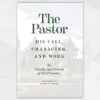Book Review: Helping without Hurting in Church Benevolence, by Steve Corbett and Brian Fikkert
Steve Corbett and Brian Fikkert with Katie Casselberry, Helping Without Hurting in Church Benevolence: A Practical Guide to Walking with Low-Income People (Chicago: Moody Publishers, 2015), 154 pages.
Whether your ministry setting is urban, suburban, or rural, you’ll inevitably encounter people stuck in poverty. How does your church lovingly engage with those who, for a variety of reasons, have little to no income and approach the church for help? Ignoring the issue and being an insulated middle-class clique is easy, but it’s not an option for those who profess to believe in the gospel of grace. At the same time, throwing money at people is really a way to keep them at a distance and therefore to only love ourselves.
A NEW BOOK
Several years ago, I read what’s since become a modern classic on poverty intervention: When Helping Hurts: How to Alleviate Poverty without Hurting the Poor… and Yourself by Steve Corbett and Brian Fikkert. Afterward, I thought, “I wish our church could do more to truly help those in financial need among us.” I also realized, however, that this was not my primary calling as a pastor (cf. Acts 6:1–7). I simply started praying that God might raise up the right people in our body who could take some of the ideas found in When Helping Hurts and run with them.
Recently, God has answered those prayers. We now have a small team of church members working through how we can genuinely love our brothers, sisters, and neighbors who find themselves in poverty. And thankfully, Corbett and Fikkert have written a short follow-up book that functions as the perfect guide for any church seeking to implement a wise approach to what has been called benevolence, diaconal work, mercy ministry, or compassion ministry. The book is titled Helping Without Hurting in Church Benevolence: A Practical Guide to Walking with Low-Income People.
WHAT IS POVERTY?
The authors begin with a theological definition of poverty that includes more than just material need. We’re all poor in the sense that we have experienced brokenness in our relationships with God, self, others, and the rest of creation. The ultimate hope of salvation is only found in the reconciling work of Christ. Sanctification is a messy, life-long process for all believers as we are restored to God’s design for us as image-bearers. Framing the issue this way prevents poverty alleviation from becoming a prideful attempt at “playing god.” The materially poor and the materially non-poor are both broken and need each other.
When poverty is defined exclusively as a lack of money, then we try to fix it with handouts, which ends up doing spiritual damage to everyone involved. Think of churches that give away hundreds of backpacks to impoverished school kids while taking pictures for their newsletter. This is not helping anyone in the long-term. We need to move away from paternalistic practices that promote dependency and demean objects of “charity” and instead encourage empowering relationships that aim for long-term, positive change.
Therefore, it is important to distinguish relief from rehabilitation and development. Relief is “stopping the bleeding.” There are times when people need immediate material assistance in the face of a crisis. However, Corbett and Fikkert demonstrate that “one of the most common and detrimental mistakes that North American churches make in their benevolence work is using a relief approach when the situation calls for development.” Development means doing things with others, not to them or for them—and it fits very nicely with discipleship Any serious engagement with those in poverty will require entering into relationships that address the root causes, not just the symptoms.
SUMMARY
There are many avenues and arenas for engaging the issue of poverty, and certainly not every local church is required or recommended to have a formal, structured benevolence program. But for those who decide to go this route, this book will walk you through all the steps to get started.
First, the book will help you create a Benevolence Philosophy and Policies document that your church can unify around. Corbett and Fikkert provide a list of 19 questions that need to be answered in such a document and they comment on each one.
Then they offer detailed guidance on how to create an Intake Form. The authors suggest most people approaching the church for financial assistance should work through this form with a member of the benevolence team.
Next, the book explains the essential elements of an Action Plan. Here the key is making sure the person in poverty is put in the driver’s seat and those from the benevolence team are seen as allies or champions in an asset-based, participatory process.
The book also provides creative ideas and links to online tools. There are helpful suggestions for recruiting and training volunteers for a benevolence ministry, creating a Community Resource Directory so you know what social services are already available around you, and coordinating this ministry with other aspects of the church.
A great strength of the book is that it assumes a healthy ecclesiology. The “ordinary ministry” of the church—preaching, baptism, the Lord’s Supper, accountability, discipline, prayer—is not undermined but explicitly encouraged and honored throughout. The gospel is clearly defined and the need for it to be verbalized in benevolence work is underscored. Sin and the need for personal responsibility never gets minimized, yet there is helpful awareness-raising information on contributing external factors like trauma and institutional racism. Poverty is complex and thus requires addressing individual behaviors, abusive or exploitive people, oppressive systems, and demonic forces.
The last chapter offers test cases to help the reader see what this approach would look like in different scenarios when people approach the church for money. Of course, there’s no one-size-fits-all approach, but biblical wisdom and dependence on the Holy Spirit’s guidance is required. Corbett and Fikkert want us to be informed but not paralyzed. They give great advice: start small, start fast, and succeed!
CONCLUSION
Our church is located in a gentrifying center-city neighborhood that is anchored by a university and has an abundance of expensive lofts, condos, and townhomes populated by professionals. And yet, immediately surrounding our building there are government subsidized housing projects that are not going anywhere. We want to be a church for everyone here—a compelling community that primarily has Christ in common, not socio-economic class. For this to happen, we felt we needed a benevolence ministry that is biblical and informed by best practices. This little book will be an indispensable resource for us and I am sure many other churches.








